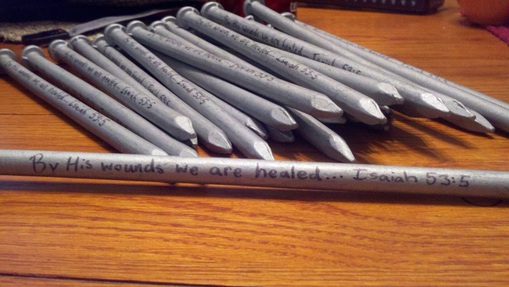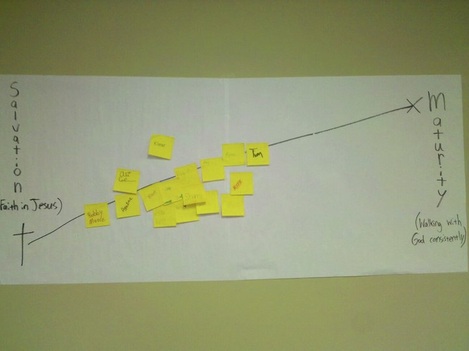We all know that some people learn best by hearing, some learn best by seeing, and some learn best by doing. It's important for us as youth workers to engage students in a multi-sensory capacity so that we can give them an opportunity to encounter God's truth in the way that speaks to them most effectively.
So, whenever an opportunity presents itself for me to teach with words, visuals, and something tangible, it's exciting. Last week I spoke on the cross, and during a response/prayer time at the end, I tried to engage students visually, audibly, and tangibly. First, we had a video playing (see below) featuring a "Jesus Painter" (there are several of them, I'm not sure which one he was) that students could watch. During the video the song "By His Wounds" was playing. Finally, I gave each student a 10-inch metal spike to hold during this time, as a reminder of the price Jesus paid for us and as a physical point of focus. They were able to take these home as well as a reminder/keepsake of the night.
It was a great experience! I recommend it, but with this disclaimer - I gave out the spikes BEFORE the message, and did so with a VERY strict admonishment that they were for a prayer experience later in the night and they were NOT to be used to stab your neighbor, or poke holes through the pages of the youth room Bibles, or carve your name on the back of a chair, etc. etc. Because I did this I think it went well, but I think it's crucial that you address the potential distraction that they could be (this goes for any tangible illustration you use).
Let me know if you use this and how it goes!
Last week we did a powerful activity to end a message from our "Now is the Time" series called "Now is the Time to Be Real". We were talking about being open and honest with each other, and the importance of sharing our struggles and secrets and sin with a safe, caring community. Call it confession if you will.
I had given each student a blank card and a pen, and I told them to take some time to pray and think about a secret, a struggle, a habit, an addiction, a sin, SOMETHING that they were holding on to that was hurting their relationship with God. I told them to write it as non-specifically as possible on the paper (as to not give themselves away) and then to bring it to the front of the room and put it in a bucket. I told them I would read them aloud and then throw them away, and that I wanted them to know - just for a second - what it would feel like to have whatever they had written out there, spoken aloud, shared with the group, in hopes that they would understand how opening up about these things could lead to freedom from them.
I did encourage students that if they weren't ready for this step, or uncomfortable in any way, to simply put a blank card in the bucket.
I was staggered by the response. I only had a few blank cards, and the ones I read aloud were dripping with pain. "I don't have anyone I can trust." "I struggle with lust and pornography." "I hate the way I look." It was powerful.
I finished by challenging the youth to find someone(s) they could share these things with and go deeper.
It was an amazing exercise, and one you could use with your group as well!
You are the light of the world—like a city on a hilltop that cannot be hidden. No one lights a lamp and then puts it under a basket. Instead, a lamp is placed on a stand, where it gives light to everyone in the house. In the same way, let your good deeds shine out for all to see, so that everyone will praise your heavenly Father. - Matthew 5:14-16
I've taught on this passage several times in youth ministry. It's a great illustration that Jesus gives regarding our responsibility to shine in the darkness. This go around I wanted to do something different though, so I set out three objects: a light bulb, a picture of the moon, and one of those glow-in-the-dark stars you can put on your ceiling.
Then I went through something along these lines:
Light Bulb
This bulb, when illuminated, can light up a whole room. But can this bulb, by itself, produce light? No. What does it need to shine? (Answer - it needs to be plugged in to a power source.)
The Moon
The moon, when it's full, can be a source of light in the darkest night. But does the moon, by itself, produce light? No. What does it need to shine? (Answer - it needs to be tilted toward the sun so it can reflect its light.)
Glow-in-the-Dark Star
This star, when you turn off the lights, glows a comforting light. But how does this star get its glow? Does it, by itself, produce light? No. What does it need to shine? (Answer - it needs to be in the light so it can absorb it and then re-emit it as it glows.)
Then you ask students something like this: now what about you? Does a human being, by him/herself, produce light? No. What do we need to shine? (We need God's presence, His power in our lives.)
Then you could ask students what item they think most represents us - are we more like the bulb, needing to be plugged in to the Source of power; are we more like the moon, we need to be turned toward God so we can reflect His light; or are we more like the star, we need to be in God's presence, absorbing His light so we can re-emit it?
When I did this with students, it was awesome! Object lessons can be a powerful tool to use with your group, and every time a student sees a light bulb, one of those stars, or the moon, they may remember that they are called to be the light of the world!!!
If you're doing a message/study on spiritual growth any time soon, you can use a short quiz I came up with to get your students talking. Click right here to download the "Ready.Set.Grow!" quiz. (Tip: right-click on the link, then select "save target/link as".) With quizzes like this, you have to be careful to remind students that it's just a piece of paper, not an official diagnosis of their spiritual health, and the whole point is simply to get them thinking about their spiritual growth. I used this quiz and then just asked one simple question after it, before leading in to the rest of the message - "In the last year, do you feel like you've grown a lot, a little, or not at all?" Also, a great and more open-ended idea to get your students talking about spiritual growth is to create a "graph" like the one above I drew on butcher paper. Label one end as "salvation" or "the beginning of my walk", and label the other end as "spiritual maturity" (using those words alone can lead to a good discussion about what spiritual maturity even is). Give each student a post-it note, let them write their name on it, and then have them all - at the same time - come up and put themselves where they feel like they are on the "growth" spectrum. Be sure to remind them that this is not a time to make comments or laugh because of where someone puts their name on the graph. ALSO, make sure you don't make the same mistake I did - putting yourself up there first, as most if not all your students will assume they need to be behind you on the growth spectrum. Oops! Then ask one question and let them discuss: "Why did you put yourself where you put yourself?" I was amazed at the honesty and insight our young people offered up during this exercise. It was awesome! If you use either of these ideas, let me know how it goes! - Tim
|




 RSS Feed
RSS Feed
